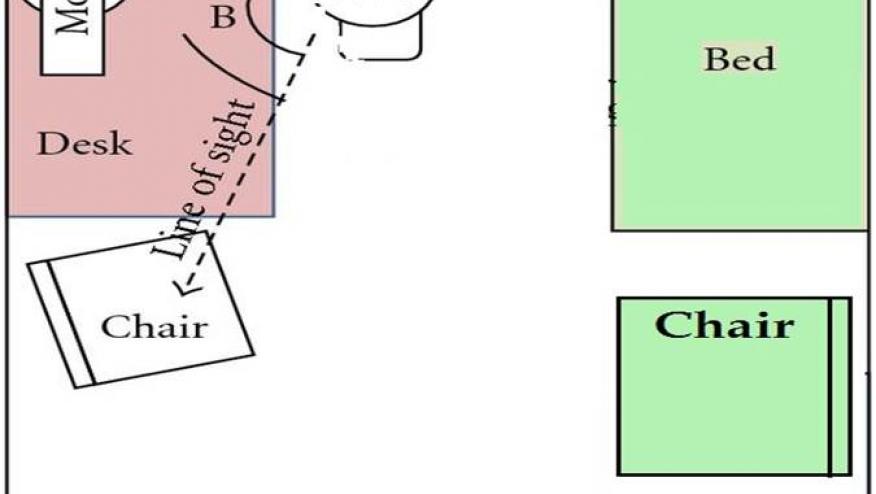Why My Patients Sit Where They Sit Save

I used to do this bit where I would open a lecture with a psychoanalytic profile based on how one eats an Oreo. While more entertaining than fact, the way you eat the Oreo probably says something about your personality.
There are whole biters, nibblers, dunkers, twist/lick/tossers, and the curious wafer-only eaters. The purpose of the bit was to make you think about yourself (and others).
But what do you think about where your patients sit? You may have never considered this or noticed what's going one? I have, and I've struggled to understand the psychology that drives patient choice of seating.
This discussion is all based on my curious observation that when I enter the exam room, I usually find the patient sitting in the wrong chair. Meaning, he/she is not seated where I would expect the patient to sit in a medical visit.
I’ll accept that where a patient sits may differ between physicians, practices types, seating quality and patient comfort. I’ll also accept this may be a figment of my keen observational skills. Nonetheless, errant sitting occurs in both the new and experienced patient medical visits, and accounts for at least 12 seconds of quality time 10-20 times a day.
My unofficial statistics on seating behavior shows that 55% of patients sit in the chair furthest from the doctor. This is what has me unglued. Is this a psychologic or feng shui issue? The remaining 25% are on the exam table and 20% will (correctly) sit next to the doctor's desk and computer.
 My question is, why does this happen? Let’s assume body odor or talk-spitting are not the problem. Then why would someone who schedules and pays for my care and consultation choose seating furthest from the action? Is this a vote of distrust? Non-confidence? Fear of the idiot box computer?
My question is, why does this happen? Let’s assume body odor or talk-spitting are not the problem. Then why would someone who schedules and pays for my care and consultation choose seating furthest from the action? Is this a vote of distrust? Non-confidence? Fear of the idiot box computer?
Where you sit has been been the subject of psychologic analyses, and there are several treatises on the subject. This issue comes up in situations beyond the exam room: classrooms, interviews, business meetings, the dinner table, etc. Each says something about the sitter. Is he/she collaborative or confrontational, engaging or withdrawn, confident or curious, uncomfortable or tired?
This is what I can surmise from my quick study of the issue. There are four places one can sit in my exam room.
The Physician's Rolling Stool
Who sits here: four-year-olds, physicians and the socially inappropriate rule breakers (hopefully there is no overlap in these 3 possibilities).
Interpretation: Stools are meant to be mobile and space economic. It is not a natural choice, especially for those with arthritis or pain. Children I can understand; the stool has a pneumatic lever and it doubles as a time-waster toy until the damage is done. The socially inappropriate adult sits here as a show of dominance, authority and a desire to be the center of attention. After all, performers and storytellers love to sit on stools. And then there's the doctor (for all the aforementioned reasons).
The Exam Table
Who sits here: Sick people, rule followers, and sleepy heads.
Interpretation: I perform my history and the exam with the patient seated in a chair. The table is occasionally used for abdominal, neurologic or exams of those who are frail or obviously ill. Hence, for the remaining 95% of patients, finding someone who voluntarily sits on the table is unnerving. Of course, there are the rule-follower patients who have been taught to sit on the table in other offices, like the gynecologist. Sleepy heads are either insomniacs who treasure any recumbent space or the ones smart enough to fill the doctor wait with a refreshing, power nap.
The Chair Furthest (from the Doctor's Desk)
Who sits here: Most new patients, many follow-up patients, and those who would rather be in the dentist chair or waiting room (instead of this exam room).
Interpretation: It's actually hard to discern why a patient starts out with the most possible space between you and them. Is it natural or are they subliminally worried, cautious, wary, defensive, competitive, judgemental or aloof? Migration to this chair is likely some form of self preservation. It could also be that exam rooms with a desk and a computer are viewed as where the devil's work occurs. The desk may be a threatening, territorial divide or communication barrier. Patients need to be taught how and why (if) you use a desk and computer.
The Chair Next to Doctor's Desk
Who sits there: Happy collaborative types, the unafraid, and the well trained
Interpretation: Psychologists say that those who sit next to you (parallel or cornered) tend to be causal, positive, friendly, collaborative. For many, it's not till the fourth or fifth date (visit) that they will assume the safe position you prefer. Until then you just have to wonder why.
Finally, I'm working on this formula wherein the distance between me and the patient, divided by the number chair/seating options equals my Q rating (likeability score). Maybe I can get OMERACT to study this.
Where do your patients sit? I'd love to hear your thoughts and observations.
Next week we’ll talk about the patient hand shake - creepy or great?










If you are a health practitioner, you may Login/Register to comment.
Due to the nature of these comment forums, only health practitioners are allowed to comment at this time.